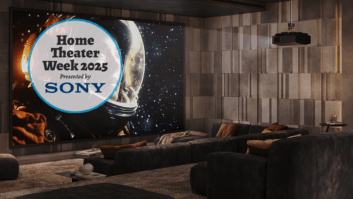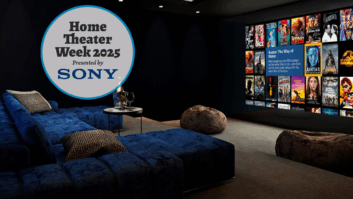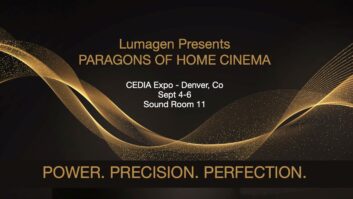Several years ago Bill Skaer was asked to participate on a panel with his peers at CEDIA EXPO in Dallas. The topic of the session was “Industry Success Stories,” and though the Dallas-area dealer hardly considered his modest operation worthy of recognition, he accepted the invitation.
When the panel’s moderator went down the line and asked the invited dealers if they had a showroom or a retail sales floor or multiple locations, everyone raised their hands. Everyone but Skaer. Every time, it seemed, he was the exception to the rule. Eventually, the audience became so fascinated with Skaer that all of their questions became targeted toward this president of the little Texas company, called “Eric Grundelman.”
“How can you do so well with your business when you have no showroom, no retail showroom and a small staff?”, someone asked. “I’m just a better salesman than all of these other guys,” Skaer joked, in his typically rapid-fire, Texas lilt. “Those things are crutches; I don’t need them.”
After years of truly believing his statements, Skaer recently found himself eating his words. Not only did he finally relent and build his first home theater demonstration facility this past year, but he did it in grand Texas style, making his a fly-in theater.
Skaer’s personal story starts way back in 1979 following his service in the Air Force. Having realized he would need supplemental income to augment his management analyst job for the Small Business Administration, Skaer began selling major appliances for the now-defunct discount department store called Woolco. That’s where he met a high school kid, and his future business namesake and partner Eric Grundelman, who was working part-time flipping burgers at the store’s snack bar.
“The store was selling the first video recorders on the market, and customers kept asked us if we could hook them up at their houses. They couldn’t figure out how to run those things,” Skaer chuckled. “Before you knew it, Eric was the one out their hooking those things up for 30 bucks a piece.”
That doesn’t sound like a lot of money now, but at the time it was a much as Grundelman was paid for a whole week of part-time work at the Woolco grille. And, before long, his little side business started to take off as customers also began asking Grundelman to solve their antenna problems and to help them with their stereos. Skaer noticed that the soon-to-be high school graduate showed great technical aptitude and an inate ability to educate his customers on how to use their audio and video gear.
By January 1, 1980, Grundelman had graduated and Skaer had seen enough. That’s the official date he helped Grundelman launch a full-fledged business. Meanwhile, Skaer continued to work full-time elsewhere, including at an independent electronics store in Dallas. It was in job where Skaer says he learned how to run a “lean” company that could remain responsive to the trends in the market.
“It gave me a great feel for how to be in control of the business, enough to where you know when things need to change with the times,” Skaer recalled.
While Grundelman made a name for himself, literally, with the company, Skaer handled much of its buying and selling at night and on the weekends. It wasn’t until 1985 that Skaer finally quit his “day job” and came on full-time with Grundelman.
“From that point on we started rockin’ and rollin’ with the sales side,” Skaer said.
Eric Grundelman (also known as Video Accessories Plus Inc. to most manufacturers) became one the first companies in the industry to focus exclusively on selling and installing A/V equipment without a showroom and/or a storefront.
“I had been going to CES with the other company, and that summer I went to the show with a vengeance,” Skaer said. “I met with a lot of manufacturers and, of course, lots of them laughed at us. They didn’t understand what we did and didn’t understand how this could work. They would ask, ‘If you don’t have a showroom, and if you don’t have something to show people, how in the world can you ever sell this equipment?’”
Grundelman and Skaer eventually lined up Soundcraftsman as their first manufacturer. Others soon followed. “We gradually picked up more lines, and now we’re direct with over a 150 manufacturers,” Skaer said.
Until just recently, Skaer and Grundelman stuck with their principals, remaining lean and, therefore, more responsive to market changes. Even after he had begun focusing all of his attention to the installation company, Skaer says his intention was to adhere to a five-day-a-week operation. “I worked in retail for all those years before I committed to this company, but I didn’t want to work on Saturdays anymore,” he explained. “At the same time I wanted to be able to give my people a reasonable living and enable them to have a life outside of work.”
Any successful business owner can point to significant events in their lives, which have made them who they are today. For Skaer, the first of these events occurred in 1986, shortly after securing his largest project to date.
“Right around that time I met representatives for ADA [Audio Design Associates] at CES in Chicago,” he remembered. “Peter McKean [the late president and founder of ADA] taught me a lot about how to take care of customers, how to deal with higher-end clientele and how to be able to meet their expectations and to exceed them. He’s the guy who really taught me about selling really high end products.”
McKean, Skaer says, also told him that the key to success in his business is learning to deliver something that is so unique and compelling that people truly have to have it.
“I didn’t know anything about that kind of selling before,” Skaer said. “My sales style was a lot more directed toward price. I finally realized that price, though ultimately important, was not the most important thing for our customers.”
Despite this philosophy, Skaer and Grundelman still believed that their’s would not be a business solely focused on “cherry picking” only the elite projects. “We want to do projects of various sizes to keep our guys busy,” Skaer explained. “People ask me what’s the smallest job we’ll take, and I’ll say, ‘Eighty-seven fifty.’ They’ll say, ‘Eighty-seven thousand, five-hundred?’ and I’ll say, “No, no, no, eighty-seven dollars and fifty cents; that’s what it will cost to get me out to a client’s house if they need something taken care of.”
In other words, relationship building is the more important than budgetary standards. This philosophy was also inspired by the advice of Peter McKean. “He built relationships with his customers and was far more than a salesman to them; he was a friend, a confidant and really got to know their lifestyle and understand their needs,” Skaer said. “Our customers are far more like our friends than they are a traditional customer. We want to know about their kids, the kind of car they drive and the trips they take. These things allow us to take care of them better in all of these electronic things that we do. The guy who’s going to be a ‘Fararri guy’ or a ‘Gulfstream IV guy’ is probably going to be somebody who wants some pretty unique and neat stuff. A guy who drives a Volvo…that’s a whole different game.”
Speaking of Gulfstream IV guys (owners of private aircraft, that is), it was the idea of catering to these folks, in particular that partially created the inspiration for the Eric Grundelman Fly-In Theater showroom concept in Mesquite, Texas. Skaer, having gradually built a stable business with strong core of trained installers and a dedicated management team of controller, Gary Travis, and general manager, Randy Presley (formerly manager of several Best Buy and Circuit City stores around the country), Skaer finally realized it was time to break his Number 1 rule and to build a showroom.
“I was timid about this sort of thing for a really long time,” Skaer admitted. “But I’ve really come out of my shell after what I have learned from the CEDIA Management Conferences. Now I realize that I need to play the role of visionary.”
That vision, for Skaer, focused on finding an innovative way to improve his company’s ability to sell an “experience” instead of products and, at the same time, finding a better way to cater to the busy schedules of its wealthy clients. Both ideas led back to the fact that both Grundelman and Skaer are licensed pilots and own private aircraft.
“When our customers learned this, more and more of them turned out to have runways on their ranches for us to use,” Skaer explained. “Before long, we would be flying down to take care of projects for customers all over this end of the country. Later on we bought a bigger airplane and were able to do longer distance projects in Wyoming, Arizona, New Mexico, Colorado, Arkansas and Louisiana. I can’t tell you have important having that airplane has been to our business.”
Add to that a specially designed and fully stocked, 36-foot job-site trailer, and Grundelman has a fully mobile operation. The Grundelman team is able to fly to a project in their own plan, have their materials shipped in as needed and then store them in their own facility on location. While this concept works well most of the time, Skaer recently envisioned an even more ingenius way to combine his custom installation business and the love he and Grundelman have for aviation.
“We made a deal with the City of Mesquite and the FAA that allowed us to buy a couple airplane hangars and zone them for business,” Skaer explained. “Then when it came to building a theater, we wanted to do something kind of different. It occurred to us that a lot of our customers come from all over the place, and that it, therefore, made more sense to have people fly in directly to see a really good example of what we do.”
This Fly-In Theater concept was supported by CAT president, Brian Barr. Skaer says that Barr made a convincing argument that a high-end showroom was the best way for Eric Grundelman staff to sell the “experience” of a CAT-engineered audio system and to make the experience somewhat “duplicatable” on future projects.
“We’ve been having really good success with our existing customers scheduling to fly in here and look at this system. We’re selling projects that way a lot now,” Skaer said. “Lots and lots of the customers in this industry either have their own aircraft or have access to aircraft. Skare also has opened up his demo thater to other dealers for a fee.
“The theater would cost someone about $750,000 to build.” Skaer noted. “I built it outrageously strong, so we wouldn’t have rattles and things. I don’t know anyplace else a customer could go that they could so conveniently walk in, get the experience of the lifetime and back out in a very short period of time.”
In addition to the theater, Skaer and Grundelman’s airport facility includes a training space, a technical room and a warehouse.
Skaer says that as he hires more sales people to grow his business, he will be able to provide them with the best tools possible. “Let’s face it, there are not that many people who can go out and sell projects that are hundreds of thousands of dollar or millions of dollars without ever having shown anybody anything,” he explained. “I finally understood that for me to have other people be able to this, they’re going to need some tools.”
While he acknowledges wanting to sell as many theaters with CAT audio technology and Runco projectors (both are currently featured), he more than happy to sell other speaker lines and other projector lines. Again, he and his staff will be selling an experience, not a product.
The end result is something Skaer may not have learned had it not been for his years of hard work and extensive volunteer work with CEDIA and his education at the association’s Management Conference. “The education I’ve gained has been invaluable; in the downturn economy I’m growing instead of contractingmy business,” Skaer said, “I’m doing this because it’s going to come back, and it’s going to come back pretty fast. Those of us who are still in business and who have made the appropriate investments during the downturn are the ones who are going to benefit the most from the upswing.”
Jeremy Glowacki is editor of Residential Systems.







